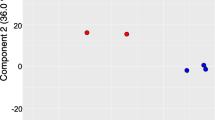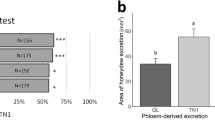Abstract
The English grain aphid, Sitobion avenae Fabricius (Hemiptera: Aphididae), and bird cherry-oat aphid, Rhopalosiphum padi L. (Hemiptera: Aphididae), are two common herbivore pests that have devastating effects on wheat production worldwide. To tolerate herbivores, plants coevolved various biological and morphological features. The present study focused on the characterization of the S. avenae- and R. padi-tolerant features in the winter wheat line XN98-10-35 under field conditions. The yield loss experiment revealed that XN98-10-35 presented strong tolerance to S. avenae and R. padi feeding, as we observed a small 100-kernel weight decrease induced by S. avenae and R. padi. Examination of the ultrastructure of the flag leaves revealed that XN98-10-35 exhibited a greater number of stomata and a larger stomata size than the controls. In comparative gene expression profiling tests, the expression levels of the candidate genes SaEST1 and SaEST2, which are putative photosystem I assembly protein Ycf3 and vegetative cell wall gp1-like protein, were up-regulated several-fold in the flag leaves of XN98-10-35. Additionally, genes associated with sucrose synthase and starch synthase were up-regulated in the flag leaves of XN98-10-35. These findings increase our understanding of the molecular mechanism underlying tolerance to S. avenae and R. padi infestations in XN98-10-35 and will allow rapid breeding of tolerant cultivars.






Similar content being viewed by others
References
Arzani A, Lapitan NLV (2007) Genetic variation for resistance to Russian wheat aphid in F2-derived families of wheat (Triticum aestivum L.). J Agric Sci Technol 9:55–60
Blackman RL, Eastop VF (1984) Aphids on the world’s crops: an identification and information guide. Wiley, Hoboken
Elbert A, Haas M, Springer B, Thielert W, Nauen R (2008) Applied aspects of neonicotinoid uses in crop protection. Pest Manag Sci 64:1099–1105
Fereres A, Lister RM, Araya JE, Foster JE (1989) Development and reproduction of the English grain aphid (Homoptera: Aphididae) on wheat cultivars infected with barley yellow dwarf virus. Environ Entomol 18:388–393
Gutsche AR, Heng-Moss TM, Sarath LG, Twigg P, Xia Y, Lu G, Mornhinweg DW (2009a) Gene expression profiling of tolerant barley in response to Diuraphis noxia (Hemiptera: Aphididae) feeding. Bull Entomol Res 99:163–173
Gutsche AR, Heng-Moss TM, Higley LG, Sarath G, Mornhinweg DW (2009b) Physiological responses of resistant and susceptible barley, Hordeum vulgare to the Russian wheat aphid, Diuraphis noxia (Mordvilko). Arthropod-Plant Inte 3:233–240
Haile FJ, Higley LG, Ni XZ, Quisenberry SS (1999) Physiological and growth tolerance in wheat to Russian wheat aphid (Homoptera: Aphididae) injury. Environ Entomol 28:787–794
Hu ZQ, Zhao HY, Thomas T (2013) Modification of non-vector aphid feeding behavior on virus-infected host plant. J Insect Sci 13:28
Hu XS, Liu YJ, Wang YH, Wang Z, Yu XL, Wang B, Zhang GS, Liu XF, Hu ZQ, Zhao HY, Liu TX (2016) Resistance of wheat accessions to the English grain aphid Sitobion avenae. PLoS ONE 11:e0156158
Inayatullah C, Webster JA, Fargo WS (1990) Index for measuring plant resistance to insects. Entomologist 109:146–152
Kerchev PI, Fenton B, Foyer CH, Hancock RD (2012) Plant responses to insect herbivory: interactions between photosynthesis, reactive oxygen species and hormonal signalling pathways. Plant Cell Environ 35:441–453
Laura S (2008) Drawing the future: stomatal response to CO2 levels. Plant Signal Behav 3:214–217
Liptak CS (1995) Problems with pesticides in the landscape: resurgence, residue and resistance. Bios 66:39–44
Liu Y, Wang WL, Guo GX, Ji XL (2010) Volatile emission in wheat and parasitism by Aphidius avenae after exogenous application of salivary enzymes of Sitobion avenae. Entomol Exp Appl 130:215–221
Liu XL, Yang XF, Wang CY, Wang YJ, Zhang H, Ji WQ (2012) Molecular mapping of resistance gene to English grain aphid (Sitobion avenae F.) in Triticum durum wheat line C273. Theor Appl Genet 124:287–293
Livak KJ, Schmittgen TD (2001) Analysis of relative gene expression data using real-time quantitative PCR and the 2(-delta delta C(T)) method. Methods 25:402–408
Luo K, Zhang GS, Wang CP, Ouellet T, Wu JJ, Zhu QD, Zhao HY (2014) Candidate genes expressed in tolerant common wheat with resistant to English grain aphid. J Econ Entomol 107:1977–1984
Mornhinweg DW, Porter DR, Webster JA (2002) Inheritance of Russian wheat aphid resistance in spring barley germplasm line STARS-9577B. Crop Sci 42:1891–1893
Müller-Röber B, Koßmann J (1994) Approaches to influence starch quantity and starch quality in transgenic plants. Plant Cell Environ 17:601–613
Ni XZ, Quisenberry SS (2006) Diuraphis noxia and Rhopalosiphum padi (Hemiptera: Aphididae) interactions and their injury on resistant and susceptible cereal seedlings. J Econ Entomol 99:551–558
Oerke EC, Dehne HW, Schönbeck F, Weber A (1996) Crop production and crop protection: estimated losses in major food and cash crops. Agric Syst 51:493–495
Romashko YD (1970) A molecular-kinetic hypothesis of gas exchange through a stoma. Fiziologiya I Biokhimiya Kulturnykh Rastenii 2(6):628–633
Sadeghi E, Dedryver CA, Gauthier JP (2010) Role of acquisition and inoculation time in the expression of clonal variation for BYDV-PAV transmission in the aphid species Rhopalosiphum padi. Plant Pathol 46:502–508
Schotzko DJ, Bosquepérez NA (2000) Seasonal dynamics of cereal aphids on Russian wheat aphid (Homoptera: Aphididae) susceptible and resistant wheats. J Econ Entomol 93:975–9810
Sowiński P (1999) Transport of photoassimilates in plants under unfavourable environmental conditions. Acta Physiol Plant 21:75–85
Tanguy S, Dedryver CA (2009) Reduced BYDV–PAV transmission by the grain aphid in a Triticum monococcum line. Eur J Plant Pathol 123:281–289
Tétard-Jones C, Leifert C (2011) Plasticity of yield components of winter wheat in response to cereal aphids. NJAS-Wagen J Life Sci 58:139–143
Wains MS, Ali MA, Waris IH, Anwar J, Zulkiffal M, Sabir W, Rehman A, Hussain M, Miraj K (2010) Rigorous, a homeopathic medicine, effective for controlling aphids in bread wheat. J Anim Plant Sci 20:248–252
Wang CP, Chen Q, Luo K, Zhao HY, Zhang GS (2011) Evaluation of resistance in wheat germplasm to the aphids, Sitobion avenae based on (technique for order preference by similarity to ideal solution) TOPSIS and cluster methods. Afr J Agric Res 6:1592–1599
Wang CP, Luo K, Wang LM, Zhao HY, Zhang GS (2015) Molecular mapping of resistance gene to the English grain aphid, Sitobion avenae, in a Chinese wheat line XN98-10-35. Mol Breed 35:1–7
Yadav SK (2010) Pesticide applications-threat to ecosystems. J Hum Ecol 32:37–45
Acknowledgements
The authors would like to thank the anonymous reviewers for their critical comments on the manuscript and the editing services of American Journal Experts for improving the English in this manuscript.
Funding
This project was supported by the Natural Science Foundation of China (Grant No. 39970112 and 30470268), the National High Tech Research and Development Program of China (2011AA10A106 and 2009AA101102), the National Support Program of China (2015BAD27B01), the Key Scientific and Technological Innovation Special Projects of Shaanxi ‘13115’ (No. 2007ZDKG-020). Top Talents Plan Projects of Northwest A&F University and an agricultural cooperation project between China and Germany (2010/2011(04)).
Author information
Authors and Affiliations
Contributions
KL, H-YZ, and G-SZ conceived and designed the research; KL, X-JY, CL, X-SH, C-PW, YW, and Z-QH performed the research and wrote this manuscript; KL, X-JY, CL, and Z-QH analyzed the data and prepared the figures. All authors have read and approved the manuscript.
Corresponding author
Ethics declarations
Conflict of interest
The authors declare that they have no competing interests.
Ethics Approval
All applicable international, national, and/or institutional guidelines for the care and use of animals were followed. This work does not contain any studies with human participants performed by the authors.
Electronic supplementary material
Below is the link to the electronic supplementary material.
Rights and permissions
About this article
Cite this article
Luo, K., Yao, XJ., Luo, C. et al. Biological and Morphological Features Associated with English Grain Aphid and Bird Cherry-Oat Aphid Tolerance in Winter Wheat Line XN98-10-35. J Plant Growth Regul 38, 46–54 (2019). https://doi.org/10.1007/s00344-018-9808-9
Received:
Accepted:
Published:
Issue Date:
DOI: https://doi.org/10.1007/s00344-018-9808-9




